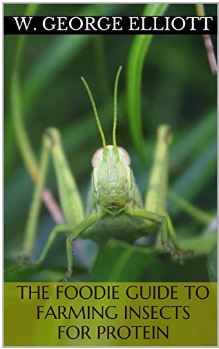|
I can’t argue against logic. When I started researching edible insects for my eBook “The Foodie Guide For Farming Insects For Protein” I discovered a lot of truths that made my beef and pork eating habits seem a little light on protein. So I experimented a little and found that I liked cricket pasta. It was my way of compromising the mix between eating insects and how to actually do it and get past the creepy part.
In my research, which was not for a masters thesis but probably could have been, showed me that although a good portion of the world’s population was already eating insects as part of their diet, there were many to choose from. Figures currently place the number of edible insect species on Earth in the “over 1,900” range. So, in order to spread some logic, here are three reasons why you should consider entomophagy. 1 – Good For The Environment When you compare the numbers, it becomes clear that insect farming is a better choice. Livestock occupy 30-percent of the globe and emit greenhouse gases at levels that exceed all of the world’s transportation networks combined. 2 – Use Little Water To Grow Agriculture uses 70-percent of the water on the ice-free portion of the planet to produce crops with animal protein requiring 100 times more than farming protein from grain. Insects use far less water and can still be farmed during drought conditions. 3 – High Protein Values Insects contain high levels of protein compared to meat and also contain good fats and measurable amounts of fibre. In fact, some of the fats found in insects can contribute to preventing certain types of heart diseases. If that’s not enough, consider that insects are becoming popular additions to several culinary dishes. It’s no longer exotic to dine on a chocolate covered cockroach as edible insects are becoming more mainstream as ingredients in several protein health bars. The reasons for this are really quite logical – the high quality of the protein that is cheaper to produce. For more information on how to start and maintain your very own cricket farm – which will take little space in your home or garage – why not take a look at my eBook? “The Foodie Guide To Farming Insects For Protein” is available from Amazon for just $3.99 USD. It not only details how to get started in cricket farming, it includes a few recipes to get you started on enjoying your crop as soon as you are ready to harvest.
0 Comments
We all need protein. It’s the juice that keeps us healthy in that the body uses it to build and maintain muscles, organs and other tissue. In fact, the average human body contains 75-percent protein. It is pretty easy to find in food sources and typically is broken down into two different kinds of proteins: complete and incomplete.
The complete proteins come from animal sources where incomplete proteins are available from plant sources. There are a variety of high-protein foods that come from both sources but one that is continuing to gain more and more attention is protein coming from insects. That’s because a diet containing insects is packed with a lot of extras. Entomology researcher Dr. Arnold van Huis of Wageningen University in the Netherlands says that insects provide an excellent source of nutrition. His studies show that insects are in many cases more nutritious than animal meat with crickets providing twice the protein of beef when measured ounce for ounce. But that’s not all. Cricket protein is actually one of the better types of protein as it also contains all nine essential amino acids that your body requires. This means that a diet that contains crickets can be good for your heart as a study recently at Harvard revealed that adding more magnesium to your diet may reduce your risk of heart disease by up to 22-percent. Crickets contain five times as much magnesium – ounce for ounce – than beef. The extra magnesium can provide additional benefits such as dropping your risk of developing type 2 diabetes by about 33-percent. That’s according to researchers in Japan. Oh, and crickets also have more than three times as much iron as beef does which your body uses to assist muscles. But why such high numbers on insects such as crickets? The way insects are consumed holds the answer. A normal snack of roasted crickets or mealworms means that the crunchy little critter is ingested whole. In other words, muscle, bones and organs are all part of the snack and that delivers zinc, calcium, iron and more to your system. When conventional protein is served, it is usually just the muscle. To find out more about entomophagy – eating insects as a meal – check out my eBook “The Foodie Guide to Farming Insects for Protein” which provides more information on the nutritional value of this alternative source of protein. There are also details on how to start your own cricket or mealworm farm and a few simple recipes to get you started. |
AuthorMy name is George Elliott. I have been in the Media Industry since 1978. I spent 23 years in Broadcasting and worked in a total of six different radio stations located in southern British Columbia Canada during my career. In 2000 I switched gears and moved into the Print Media Industry at a small town, local weekly newspaper. In 2004 I bought the paper and operated it with my wife, Brenda until July 2016 when we closed it. I launched a freelance web content and article writing business from my home in January 2014. Archives
January 2019
Categories |

 RSS Feed
RSS Feed
